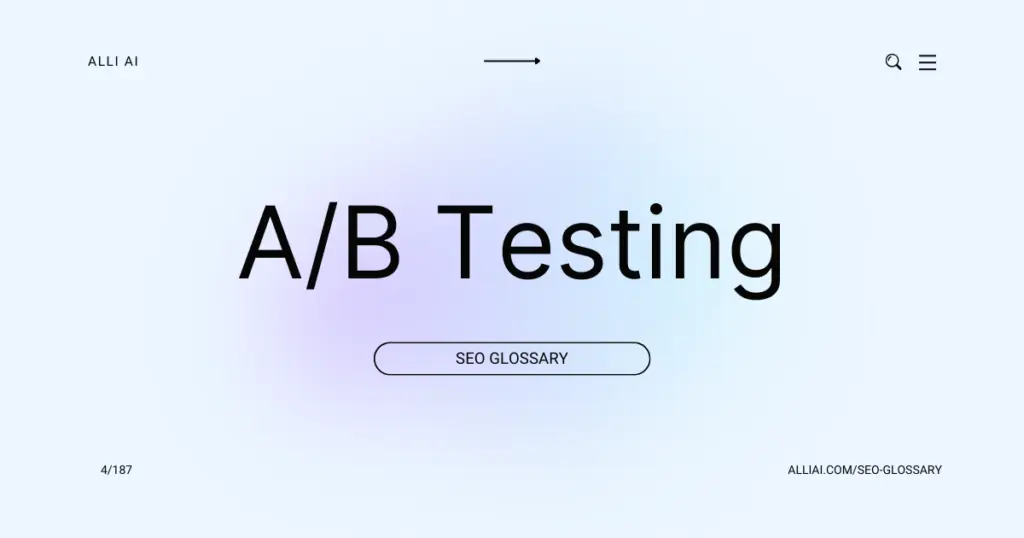What Does A/B Testing Mean?
A/B testing is a method where you compare two versions of a webpage or app against each other to see which one performs better. Essentially, you show version A to one group of users and version B to another, and then analyze which version gets a better response based on specific goals, like more clicks or higher sales. This helps you decide which changes improve user experience and effectiveness.
Where Does A/B Testing Fit Into The Broader SEO Landscape?
A/B testing in SEO primarily involves comparing two versions of a webpage to determine which one performs better in terms of organic search traffic, user engagement, and conversions. This kind of testing can reveal more effective elements like metadata, headlines, and content structures that better satisfy user intent and align with search engine algorithms.
It fits into the broader SEO landscape as a crucial part of optimizing user experiences and content. By methodically testing different SEO variables, such as page layouts, title tags, and meta descriptions, practitioners can identify which configurations yield the best results in search engine result pages (SERPs). The insights gained from A/B testing can inform broader SEO strategies by highlighting what works best for a specific target audience or market niche.
Moreover, the practice supports iterative improvements and optimization over time, ensuring that SEO tactics remain effective in the face of changing search engine algorithms and user behaviors. A/B testing aids in making data-backed decisions that can enhance both the performance metrics of a website and its overall search engine visibility.
Real Life Analogies or Metaphors to Explain A/B Testing
1. Gardening Analogy: A/B testing is like planting two types of seeds in different plots of soil to see which one grows better under the same environmental conditions. Each plot represents a different version of your web page, and the growth of plants indicates the effectiveness of each version.
2. Cook-off Analogy: Imagine two chefs competing to see who can make the tastier dish using similar ingredients but with different recipes. Each dish represents a variation of a webpage, and the diners’ preferences indicate which version performs better.
3. Fishing Analogy: Think of A/B testing as fishing with two different types of bait to see which one attracts more fish. Each type of bait represents a different web page version, and the number of fish caught tells you which bait is more effective.
4. Path Finding Analogy: A/B testing is like testing two different paths in a maze to determine which one leads to the exit more quickly. Each path represents a different version of a webpage, and the quicker route indicates the more efficient version.
5. Experimenting with Outfits Analogy: It’s like wearing two different outfits on similar occasions to see which one receives more compliments. Each outfit is like a different version of a webpage, and the compliments are feedback that helps you decide which one works better.
How the A/B Testing Functions or is Implemented?
1. Define Objective: Establish what you want to improve, such as conversion rates, click-through rates, or other relevant metrics.
2. Form Hypotheses: Create two different versions (A and B) based on your objective, with one change that might affect user behavior.
3. Identify Variables: Determine which elements will be changed in the testing versions. For instance, it could be the color of a button, the placement of a call-to-action, or the wording of a headline.
4. Segment Your Audience: Split your audience randomly but evenly to ensure that each group is statistically similar, which helps in isolating the variable effects.
5. Serve Variants: Use an A/B testing tool to randomly serve version A to one half of your audience and version B to the other half.
6. Gather Data: Collect and analyze data on how each version performed against the defined objectives. Use metrics like engagement rates, conversion rates, or time spent on page.
7. Statistical Analysis: Apply statistical analysis to determine if the differences between the performances of versions A and B are significant.
8. Implement Changes: If one version clearly outperforms the other, implement the successful version. If there is no clear winner, consider additional tests with other variables.
9. Repeat: A/B testing is an iterative process. Based on results and learnings, new tests should be planned to continuously improve and optimize the user experience.
Impact A/B Testing has on SEO
A/B testing can have a significant impact on a website’s SEO performance and user experience by allowing webmasters to compare two versions of a web page and determine which performs better in terms of user engagement and conversion rates. Optimal elements from these tests, such as page layout, content, images, and calls-to-action, can enhance the user experience, potentially reducing bounce rates and increasing time on site. These improvements can signal to search engines that the website is more valuable to users, potentially improving rankings.
However, improper implementation of A/B tests can negatively affect SEO. For instance, if search engines index both versions of the tested page, it might result in duplicate content issues. Moreover, frequent changes in website content and structure due to A/B testing could confuse search engines, leading to fluctuations in ranking.
Using proper methods such as the use of `rel=”canonical”` tags and ensuring that only one version of the page is accessible to search engines while testing is crucial to avoid SEO problems. Similarly, it’s important to analyze A/B testing data correctly and implement only those changes that have shown a statistically significant improvement to avoid degrading the user experience or SEO by chance variations.
SEO Best Practices For A/B Testing
1. Define Objective: Decide what specific goal you want to achieve with A/B testing (e.g., increase conversions, improve click-through rate, reduce bounce rate).
2. Identify Variables: Select the elements on your website or page to test (e.g., headlines, CTA buttons, images, page layouts).
3. Create Variations: Develop alternative versions of your selected elements. Ensure each variant is different enough to test the impact effectively.
4. Use An A/B Testing Tool: Utilize tools like Google Optimize, Optimizely, or VWO to set up your A/B tests. These tools will help you split your audience and serve them different versions of your page.
5. Segment Your Audience: Decide how the audience will be divided (e.g., 50/50 split, random, geo-based) for the test. Ensure it’s a representative sample.
6. Run The Test: Activate the A/B test on your website. Run the test long enough to collect significant data, typically a few weeks or until you have enough data to make statistically valid conclusions.
7. Analyze The Data: Use the A/B testing tool to analyze the results. Look at key metrics like conversion rates, time on page, or bounce rates, depending on your test objective.
8. Implement Changes: Based on the results, decide which version performed better. Implement the more successful version on your site.
9. Monitor Results: After implementation, keep monitoring the updated element’s performance to ensure the changes positively impact your overall objective.
10. Iterate: Use insights gained from this test to initiate new A/B tests and further optimize your site.
Common Mistakes To Avoid
1. Testing Too Many Variables at Once: Focus on testing one variable at a time to clearly determine which changes impact results.
2. Insufficient Sample Size: Use statistical tools and calculators to ensure your sample size is large enough to achieve statistically significant results.
3. Short Testing Periods: Extend tests over an appropriate duration to account for all variations in traffic and user behavior.
4. Not Segmenting Data: Segment test results to analyze how different groups react differently to changes.
5. Ignoring External Factors: Take into account external factors like holidays or market changes that might skew results.
6. Ending Tests Prematurely: Allow the test to run fully to avoid bias in the results.
7. Frequent Changes During the Test: Avoid making adjustments during the test, as it can contaminate the results.
8. Testing Without a Clear Hypothesis: Start with a clear, actionable hypothesis to guide the test and expectations.
9. Relying Solely on Quantitative Data: Combine quantitative data with qualitative insights for a more comprehensive understanding of user behavior.
10. Overlooking Smaller Gains: Pay attention to even small improvements; these can be significant when scaled.
11. Failing to Repeat Tests: Re-test to verify results and account for variations over time or in different markets.
12. Poorly Defined Success Metrics: Clearly define what success looks like before starting any test to accurately measure outcomes.
13. Lack of Organizational Buy-in: Ensure all stakeholders understand and support the testing process and its significance.
14. Data Misinterpretation: Double-check data analysis and involve multiple team members to mitigate misinterpretation risks.
15. Not Testing Continuously: Continually test and optimize even after achieving successful results to maintain and improve performance.






